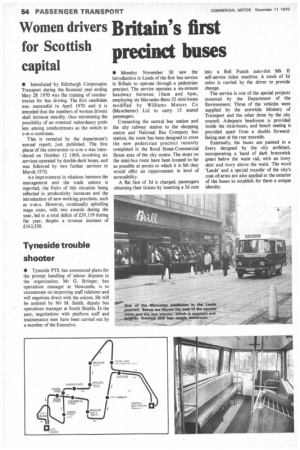Women drivers Britain's first for Scottish precinct buses
Page 56

If you've noticed an error in this article please click here to report it so we can fix it.
capital
• Introduced by Edinburgh Corporation Transport during the financial year ending May 28 1970 was the training of conductresses for bus driving. The first candidate was successful in April 1970 and it is intended that the numbers of women drivers shall increase steadily, thus minimizing the possibility of an eventual redundancy problem among conductresses as the switch to o-m-o continues.
This is revealed by the department's annual report, just published. The first phase of the conversion to o-m-o was intro' duced on October 12 1969, involving six services operated by double-deck buses, and was followed by two further services in March 1970.
An improvement in relations between the management and the trade unions is reported, the fruits of this situation being reflected in productivity increases and the introduction of new working practices, such as o-m-o. However, continually spiralling wage costs, with two awards during the year, led to a total deficit of L39,119 during the year, despite a revenue increase of £162,330. • Monday November 30 saw the introduction in Leeds of the first bus service in Britain to operate through a pedestrian precinct. The service operates a six-minute headway between 1 Oain and 4pm, employing six Mercedes-Benz 22 mini-buses modified by Williams Motors Co (Manchester) Ltd to carry 13 seated passengers.
Connecting the central bus station and the city railway station to the shopping centre and National Bus Company bus station, the route has been designed to cross the new pedestrian precinct recently completed in the Bond Street-Commercial Street area of the city centre. The stops on the mini-bus route have been located so far as possible at points to which it is felt they would offer an improvement in level of accessibility.
A flat fare of 3d is charged, passengers obtaining their tickets by inserting a 3d coin into a Bell Punch auto-slot Mk H self-service ticket machine. A stock of 3d coins is carried by the driver to provide change.
The service is one of the special projects mounted by the Department of the Environment. Three of the vehicles were supplied by the erstwhile Ministry of Transport and the other three by the city council. Adequate headroom is provided inside the mini-buses, and bench seating is provided apart from a double for wardfacing seat at the rear nearside.
Externally, the buses are painted in a livery designed by the city architect, incorporating a band of dark brunswick green below the waist rail, with an ivory skirt and ivory above the waist. The word 'Leeds' and a special transfer of the city's coat-of-arms are also applied to the exterior of the buses to establish for them a unique identity.






























































































































































